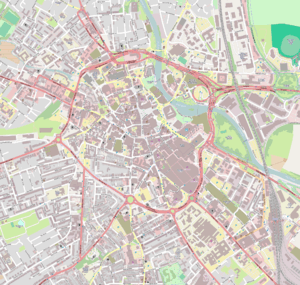St Andrew's Church, Derby
St Andrew’s Church, London Road was a parish church in the Church of England[1] in Derby, Derbyshire. It was built between 1864 and 1867[2] and demolished in 1971.
| St Andrew’s Church, Derby | |
|---|---|
 St Andrew’s Church, Derby Location within Derby | |
| 52°54′50″N 1°27′55.2″W | |
| Location | Derby, Derbyshire |
| Country | England |
| Denomination | Church of England |
| History | |
| Dedication | St Andrew |
| Consecrated | 10 May 1866 |
| Architecture | |
| Architect(s) | George Gilbert Scott |
| Groundbreaking | 29 March 1864 |
| Demolished | 1970 |
History
The corner stone for the church was laid by William Cavendish, 7th Duke of Devonshire on 29 March 1864.[3] The architect was George Gilbert Scott and the contractors were Thompson and Fryer and even though incomplete, it was consecrated on 10 May 1866 by Rt. Revd. John Lonsdale the Bishop of Lichfield.[4]
The font was designed by Scott and carved by Mr. Hall of Derby. It consisted of an octagonal bowl of grey Derbyshire fossil marble, with a clustered column of green Connemara and Red Belgian marble.
Work on the tower and spire started in 1880 and it was consecrated by the Bishop of Lichfield on 30 December 1881.[5]
The musician Ronald Binge, composer of BBC Radio Four's theme tune 'Sailing By' was a boy chorister at the church in the 1920s.
The church became redundant in the 1960s and was demolished in 1971. The parish merged with that of St Osmund's Church, Derby.
Organ
An organ was installed in 1866 for the opening of the church. A new organ was installed in 1902 by Forster and Andrews. It was modified in 1919 by Nicholson and Lord and again in 1928 by J.H. Adkins of Derby. A specification of the organ can be found on the National Pipe Organ Register.[6]
Organists
- Frederick Bentley 1875[7] - 1881 (formerly organist of St Thomas' Church, Kendal)
- Edwin C. Owston 1881 - 1884[8] (formerly assistant organist at Lincoln Cathedral)
- Walter Maxted 1884 - 1886[9] (formerly deputy organist of Canterbury Cathedral)
- Dr. Corbett 1886[10]
- Edwin C. Owston 1886[11] - 1888 (re-appointed)
- R.S. Round 1888[12] - 1890
- W.L. Dodd 1890 - 1909 (formerly organist of St Peter's Church, Derby)
- W.J. Baker 1909 - 1926[13]
- E. A. Miller 1926 - 1928
- F. Isherwood Plummer 1928 - 1933[14]
- Fred Morley 1933[15] - 1943 (formerly organist of All Saints' Church, Ripley and afterwards organist of St Giles' Church, Normanton, Derby)
- S.C. Garland ca. 1948
Bells
Eight bells were installed in the tower in 1881. Bells One to Five, Seven and the Tenor of 20 cwt, 2 qrs, 14 lbs were cast by the Mears and Stainbank foundry in Whitechapel, London in 1881. The Sixth bell had been cast for the church in 1866.[5]
References
- Pevsner, Nikolaus; Williamson, Elizabeth (1979). The Buildings of England. Derbyshire. Penguin Books Limited. p. 188. ISBN 0140710086.
- "Christchurch Cathedral and its local links". Derby Telegraph. 7 April 2011. Retrieved 4 June 2017.
- "St Andrew's Church, London Road, Litchurch". Derby Mercury. England. 30 March 1864. Retrieved 4 June 2017 – via British Newspaper Archive.
- "St Andrew's Church, Litchurch". Derby Mercury. England. 16 May 1866. Retrieved 4 June 2017 – via British Newspaper Archive.
- "Consecration of the Bells of St Andrew's Church". Derby Mercury. England. 4 January 1882. Retrieved 4 June 2017 – via British Newspaper Archive.
- "NPOR N05284". National Pipe Organ Register. British Institute of Organ Studies. Retrieved 4 June 2017.
- "St Andrew's, Litchurch". Derby Mercury. England. 29 September 1875. Retrieved 4 June 2017 – via British Newspaper Archive.
- "St Andrew's Litchurch". Derbyshire Advertiser and Journal. England. 25 July 1884. Retrieved 4 June 2017 – via British Newspaper Archive.
- "Local News. St Andrew's Church". Derby Mercury. England. 7 April 1886. Retrieved 4 June 2017 – via British Newspaper Archive.
- "Derby". Derbyshire Advertiser and Journal. England. 18 June 1886. Retrieved 4 June 2017 – via British Newspaper Archive.
- "Appointment of Organist at St Andrew's Church". Derbyshire Advertiser and Journal. England. 26 November 1886. Retrieved 4 June 2017 – via British Newspaper Archive.
- "Local News". Derby Mercury. England. 15 August 1888. Retrieved 4 June 2017 – via British Newspaper Archive.
- "St. Andrew's, Derby. Presentation to the retiring organist". Derby Daily Telegraph. England. 2 February 1926. Retrieved 4 June 2017 – via British Newspaper Archive.
- "Derby Organist Resigns". Derby Daily Telegraph. England. 23 January 1933. Retrieved 4 June 2017 – via British Newspaper Archive.
- "Derby Organist. Mr. Fred Morley appointed to St Andrews". Derby Daily Telegraph. England. 18 March 1933. Retrieved 4 June 2017 – via British Newspaper Archive.